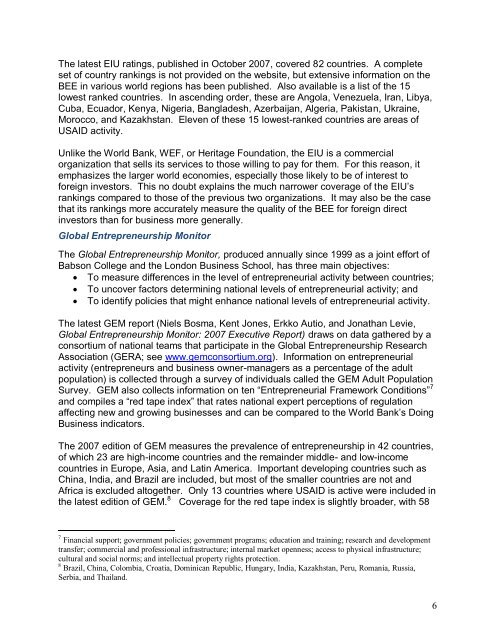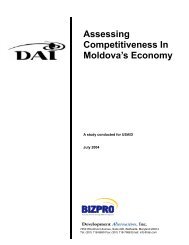Alternative Business Enabling Environment ... - Economic Growth
Alternative Business Enabling Environment ... - Economic Growth
Alternative Business Enabling Environment ... - Economic Growth
You also want an ePaper? Increase the reach of your titles
YUMPU automatically turns print PDFs into web optimized ePapers that Google loves.
The latest EIU ratings, published in October 2007, covered 82 countries. A complete<br />
set of country rankings is not provided on the website, but extensive information on the<br />
BEE in various world regions has been published. Also available is a list of the 15<br />
lowest ranked countries. In ascending order, these are Angola, Venezuela, Iran, Libya,<br />
Cuba, Ecuador, Kenya, Nigeria, Bangladesh, Azerbaijan, Algeria, Pakistan, Ukraine,<br />
Morocco, and Kazakhstan. Eleven of these 15 lowest-ranked countries are areas of<br />
USAID activity.<br />
Unlike the World Bank, WEF, or Heritage Foundation, the EIU is a commercial<br />
organization that sells its services to those willing to pay for them. For this reason, it<br />
emphasizes the larger world economies, especially those likely to be of interest to<br />
foreign investors. This no doubt explains the much narrower coverage of the EIU’s<br />
rankings compared to those of the previous two organizations. It may also be the case<br />
that its rankings more accurately measure the quality of the BEE for foreign direct<br />
investors than for business more generally.<br />
Global Entrepreneurship Monitor<br />
The Global Entrepreneurship Monitor, produced annually since 1999 as a joint effort of<br />
Babson College and the London <strong>Business</strong> School, has three main objectives:<br />
To measure differences in the level of entrepreneurial activity between countries;<br />
To uncover factors determining national levels of entrepreneurial activity; and<br />
To identify policies that might enhance national levels of entrepreneurial activity.<br />
The latest GEM report (Niels Bosma, Kent Jones, Erkko Autio, and Jonathan Levie,<br />
Global Entrepreneurship Monitor: 2007 Executive Report) draws on data gathered by a<br />
consortium of national teams that participate in the Global Entrepreneurship Research<br />
Association (GERA; see www.gemconsortium.org). Information on entrepreneurial<br />
activity (entrepreneurs and business owner-managers as a percentage of the adult<br />
population) is collected through a survey of individuals called the GEM Adult Population<br />
Survey. GEM also collects information on ten “Entrepreneurial Framework Conditions” 7<br />
and compiles a “red tape index” that rates national expert perceptions of regulation<br />
affecting new and growing businesses and can be compared to the World Bank’s Doing<br />
<strong>Business</strong> indicators.<br />
The 2007 edition of GEM measures the prevalence of entrepreneurship in 42 countries,<br />
of which 23 are high-income countries and the remainder middle- and low-income<br />
countries in Europe, Asia, and Latin America. Important developing countries such as<br />
China, India, and Brazil are included, but most of the smaller countries are not and<br />
Africa is excluded altogether. Only 13 countries where USAID is active were included in<br />
the latest edition of GEM. 8 Coverage for the red tape index is slightly broader, with 58<br />
7 Financial support; government policies; government programs; education and training; research and development<br />
transfer; commercial and professional infrastructure; internal market openness; access to physical infrastructure;<br />
cultural and social norms; and intellectual property rights protection.<br />
8 Brazil, China, Colombia, Croatia, Dominican Republic, Hungary, India, Kazakhstan, Peru, Romania, Russia,<br />
Serbia, and Thailand.<br />
6

















